Understanding Saffron Measurements: Practical Insights for Culinary Use
When working with saffron, precise measurements matter significantly due to its extraordinary value and potent flavor profile. One ounce of saffron represents a substantial investment for home cooks and professional chefs alike. This comprehensive guide provides essential information about 1 ounce of saffron, including exact conversions, practical usage metrics, and storage recommendations.
Exact Measurement Conversions for Saffron
Understanding the precise measurements of saffron helps prevent costly mistakes in the kitchen. While saffron is typically sold by weight rather than volume, knowing these conversions proves invaluable for recipe planning and cost management.
| Measurement | Equivalent | Practical Context |
|---|---|---|
| 1 ounce saffron | 28.35 grams | Standard commercial packaging size |
| 1 ounce saffron | Approximately 1,500-2,000 threads | Varies based on saffron grade and harvest |
| 1 ounce saffron | 1.75-2.25 teaspoons (loosely packed) | Volume varies significantly due to thread length |
| 1 ounce saffron | 0.125 cups | Rarely measured by volume in professional settings |
Practical Culinary Applications of 1 Ounce of Saffron
The true value of 1 ounce of saffron becomes apparent when considering its culinary yield. Unlike most spices, saffron requires minimal quantity per serving due to its intense flavor and coloring properties.
A standard culinary serving uses just 10-15 saffron threads (approximately 0.14-0.21 grams). This means 1 ounce of saffron provides:
- 150-200 individual servings for dishes like paella, risotto, or bouillabaisse
- 300-400 servings for subtle applications like breads and pastries
- Approximately 50 batches of traditional Spanish paella (serving 4 people)
Professional chefs often measure saffron by thread count rather than weight for precision. When properly stored, 1 ounce of saffron maintains optimal flavor and color properties for 2-3 years, making it a worthwhile investment for serious cooks.
Contextual Limitations: When Standard Measurements Differ
While the standard serving size of 10-15 threads applies broadly, specific culinary contexts significantly alter measurement requirements. These variations stem from cultural practices, industrial processing constraints, and medicinal applications, where thread-count standards become unreliable.
| Application Context | Measurement Variation | Verification Source |
|---|---|---|
| Traditional Persian Cuisine | 0.1-0.5g per kg of rice (vs. 0.14-0.21g per Western serving), reflecting culturally distinct usage patterns | FAO: Saffron Production, Markets and Trade (2002) |
| Industrial Food Manufacturing | Pre-ground saffron requires 20-30% more by weight due to oxidation during processing | UC Davis Postharvest Technology Center |
| Medicinal Applications | Therapeutic doses range from 30-100mg daily, requiring precise weight measurement | NIH: Saffron Supplementation for Depression (2018) |
These contextual boundaries demonstrate why rigid thread-count standards fail across diverse applications, necessitating weight-based precision in non-culinary contexts.
Economic Value of 1 Ounce of Saffron
Understanding the economic context of 1 ounce of saffron helps explain why precise measurements matter. Saffron's price reflects its labor-intensive harvesting process—each crocus flower produces only three stigmas, and it takes approximately 75,000 flowers to yield one pound of dried saffron.
Current market prices for premium grade saffron (ISO 3632 Category I) range from $10,000-$15,000 per kilogram, translating to:
- $300-$425 per ounce from reputable specialty retailers
- $500-$600 per ounce for certified organic or premium harvests
- Approximately $1.50-$3.00 per culinary serving
When evaluating how much 1 ounce of saffron costs versus its culinary yield, the investment becomes reasonable for special occasion cooking. However, improper storage or measurement can quickly turn this investment into wasted resources.
Historical Evolution of Saffron Quality Standards
The pricing structure for saffron has been shaped by evolving international quality benchmarks. These standards transformed saffron from a regionally traded commodity to a globally standardized product with precise measurement expectations.
| Year | Key Development | Measurement Impact |
|---|---|---|
| 1993 | Publication of ISO 3632:1993 | Established first global quality tiers based on color strength (crocin), enabling weight-based premium pricing |
| 2011 | Revision to ISO 3632-1:2011 | Defined Category I (crocin > 190) with 30-50% price premium over Category II, requiring precise spectrophotometric testing |
| 2018 | Amendment 1 to ISO 3632-1 | Reduced maximum moisture content from 14% to 12%, increasing net weight requirements for premium grades |
These standardization milestones explain why Category I saffron maintains 20-30% higher thread density per ounce compared to lower grades. Source: ISO 3632-1:2011, ISO 3632-1:2011/Amd 1:2018.
Optimal Storage Methods for 1 Ounce of Saffron
Preserving the quality of 1 ounce of saffron requires specific storage techniques. Exposure to light, air, and moisture rapidly degrades saffron's volatile compounds, diminishing both flavor and coloring capacity.
For maximum shelf life of your 1 ounce saffron purchase, follow these professional recommendations:
- Store in an airtight container with minimal headspace
- Keep in complete darkness (amber glass preferred)
- Maintain temperature between 50-70°F (10-21°C)
- Avoid humidity levels above 40%
- Consider dividing large quantities into smaller portions to minimize air exposure
Properly stored, 1 ounce of saffron maintains peak quality for 24-36 months. After this period, while still safe to consume, the spice gradually loses its characteristic aroma and coloring strength.
Maximizing Your 1 Ounce of Saffron Investment
Professional chefs employ specific techniques to extract maximum value from their saffron investment. Understanding how to use 1 ounce of saffron efficiently separates novice cooks from experienced practitioners.
Follow these evidence-based methods to optimize your saffron usage:
- Always toast threads lightly before use to release volatile compounds
- Steep in warm liquid (not boiling) for 15-20 minutes to maximize extraction
- Use the steeping liquid entirely in your recipe—never discard
- Grind threads with a mortar and pestle with a pinch of sugar for even distribution
- Store unused portions in vacuum-sealed containers for long-term preservation
When working with 1 ounce of saffron threads, remember that less is often more. Excessive saffron creates bitter flavors and overpowering color that cannot be corrected once incorporated into dishes.











 浙公网安备
33010002000092号
浙公网安备
33010002000092号 浙B2-20120091-4
浙B2-20120091-4